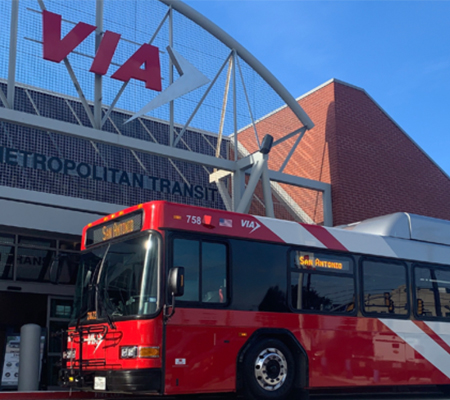The $574.3 million budget plan focuses more frequent service, improving customer amenities, enhanced safety and deeper investments in VIA’s workforce.
The budget builds on VIA’s accelerated vision for improving transit service and organizational performance, focusing on what riders value most: more frequent service, safer journeys and better access to opportunity.
Key FY 2026 Investments include:
♦ More Service & Frequency – Expanding service hours, reducing wait times, and improving travel times through VIA Link and fixed-route service enhancements.
♦ Customer Experience – Adding more shelters, improving signage and real-time information, and modernizing rider facilities.
♦ Safety & Security – Expanding the VIA Transit Police force, upgrading surveillance systems and improving lighting and infrastructure.
♦ Workforce Development – Strengthening operator retention and recruitment, expanding training and career pathways, and fostering a culture of organizational excellence.
Growing that portion of the workforce is critical for VIA’s plan to offer better service in the region. The spending plan includes accelerating those improvements — adding an additional VIA Link Zone in November and improving more than 55 routes over the year — increasing wages for all employees, investing in safety across the system and growing the agency’s capital reserve to ensure delivery of key infrastructure projects.
VIA will begin receiving revenue on Jan. 1 from a 1/8th-cent sales tax approved by San Antonio voters in November 2020. That portion of the sales tax was dedicated to workforce development for five years before becoming a permanent sales tax for VIA’s Advanced Transportation District beginning in 2026.
“This budget makes strategic investments that will help VIA deliver the improved, reliable transit system that meets the needs of our growing region,” Board Chair Laura Cabanilla said. “We’re making historic investments in our service, our infrastructure and our workforce to benefit the community today and into the future.”
VIA is accelerating the delivery of the Better Bus Plan and will complete 64% of the planned improvements within its first two years. In addition to service improvements planned for January, May and August, VIA will also launch its sixth VIA Link zone — the Southeast Zone — on Nov. 3.
“This budget is about turning resources into results. Every additional trip, every safer stop, every new operator we train is an investment that translates into real improvements for our riders and our community,” VIA President & CEO Jon Gary Herrera said. “The ultimate impact is greater mobility, stronger connections to jobs and schools, and a system that earns the trust of the people we serve.”
VIA’s focus on hiring and retaining operators is a key element critical to continued service improvement delivery across the system. VIA can only deliver on key service improvements laid out in the Better Bus Plan by growing its operator ranks. As VIA seeks to deliver faster, more frequent and more reliable service, the workforce is the backbone of reaching that goal. In FY26, VIA plans to continue growing its frontline staff while keeping administrative positions flat.
Safety is a top priority at VIA, ensuring that customers ride in properly maintained vehicles, driven by safe operators, wait in safe transit centers and stops and feel safe when they’re in VIA facilities and vehicles. This year’s budget invests in several safety measures, including:
♦ Retention and expansion of VIA Transit police personnel
♦ Technology improvements for safety personnel
♦ Safety programs
♦ Shelter-improvement program
In the new fiscal year, VIA is implementing programs with innovative cost-saving solutions, including a vehicle wellness program that is designed to add three to five years onto the lifespan of buses and save the agency $133 million over the next five years.
The board also approved VIA’s five-year capital improvement plan of $1.1 billion, which makes historic investments in transit infrastructure, such as the VIA Rapid Green and Silver lines, new vehicles, renovation of existing buildings and construction of new facilities.
